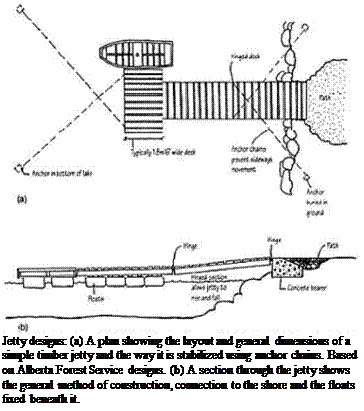One of the simplest and most effective forms of boat launch is a sloped ramp descending at a shallow angle into the water. Boat trailers are reversed down this, and the boat is slid by hand or let down by cable under its own weight into the water. It can then be moved to a jetty nearby, where passengers can board and supplies are loaded. The trailer and the towing vehicle are then moved to nearby parking, which does not intrude upon the water setting.
Launch ramps can be constructed from:
– poured concrete, which is prone to cracking, especially in areas where severe winter temperatures are likely. If damaged it is difficult to repair. It can also look most urban and too finished for wilder locations. Exposed aggregate varieties of concrete that use local types of stone will blend in better.
– reinforced concrete slabs laid side by side and linked with steel couplings. A small space is left between them and filled with gravel. These are flexible to lay, easy to replace, and can be precast off site. The gaps between them give good grip for shoes and vehicles in wet conditions. The coarser texture and gravel infill helps this type to blend into the landscape. Exposed aggregate concrete looks better and helps give a good grip.
– timber slabs, laid similarly to the concrete slabs. These do not last as long, but they are easy to lay and replace, and they do less damage to the bottoms of boats when they are hauled out of the water. Preservatives cannot be used on the timber because of the risk of the chemicals leaching into the water. The timber may become slippery where it is most frequently in contact with water.
– flat rocks, which can be laid in situ on a firmed base infilled with gravel. These may depress under the wheels of heavily laden trailers but they tend to blend with the landscape better than the other varieties, and are easier to fit and re-lay.
jetties
 |
Jetties are needed for mooring boats and float planes that land on lakes in the remotest locations. Jetties should be located in sheltered places out of the way of currents and in places where the water is naturally deep enough for the types of boat or float plane intended to use them. The design of jetties must reflect the qualities of the landscape while being designed to be fully practical.
In shallow water where levels do not fluctuate a jetty can be constructed on piles made of durable timber connected by a framework with a surface deck. Rocks can be used to infill between the piles and give some shelter and breakwater to the mooring area.
In deeper water, floating jetties may be better, particularly where water levels vary significantly. Floats can be made from well-cleaned petroleum drums (metal or plastic), blocks of polypropylene, or special proprietary floats made from plastic with flanges to fix them to frames.
The deck of the jetty can be constructed from sawn timber frames surfaced with planks. If preservatives are used, care must be taken to ensure that it is not toxic to fish or other aquatic life (see section on boardwalks in Chapter 9). Any metal fixings should be of galvanized steel. Small jetties can be taken out of the water and stored on shore over winter for repair and maintenance. Jetties can also be prefabricated, which is an advantage when they are to be transported to remote locations.
The jetty must be anchored to a fixed base on dry land, usually a concrete block, by hinges or short chains, which allow it to rise or fall with the variations in water level. The jetty consists of an access ramp or gangplank section, whose angle varies with the water level, to walk along; this joins by another set of hinges onto a floating section used to moor boats. To prevent sideways movements and twisting or buckling in waves and winds the ends of the gangplank and the offshore end of the floating jetty section should be anchored with diagonally arranged cables or struts.
Steel and timber can also be used. This is more durable and stronger, which may be required in busier locations and for less experienced boat users where buffeting is more likely. Galvanized steel frames can be prefabricated; floats can be made of metal tubes with timber decking bolted on. In places where less experienced sailors, passengers and swimmers are expected to use the facility, or where the gangplank can be steep due to low water levels, handrails should be fixed to it. This variety is a low – maintenance one, but it can also be hauled out of the water if need be. It must also be anchored to the shore as described above using cables or steel struts, which give added stiffness as well as securing the ends to prevent sideways movement. The metal frame construction is a more highly finished design appropriate to busy sites. Its more urban appearance is out of place in wilder, more remote locations.
All-metal jetties of pontoon construction are also used in marinas. Hollow metal watertight boxes are the basic unit, with or without timber decking, and bolted together in various combinations, which can be expanded as demand increases if the lake can support the number of boats. This type of design is at the most urban range of the spectrum from the simple wooden structures described above, and is appropriate for the most gregarious locations.
![]()



